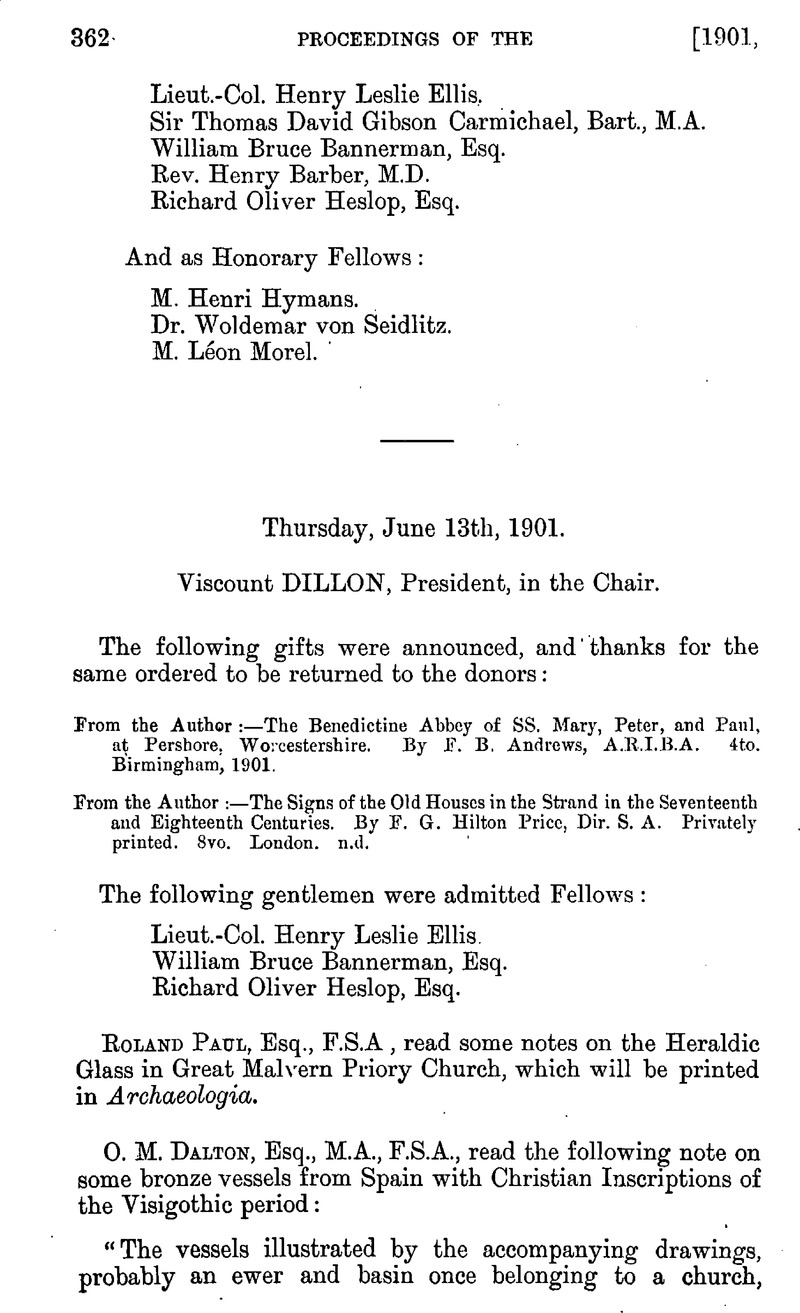No CrossRef data available.
Published online by Cambridge University Press: 10 May 2010

* Hübner, , Inscriptionum Hispaniæ Christiananm Supplementum, No. 529, p. 135 (Berlin, 1900)Google Scholar.
page 366 note * On the Annunciation in Early Christian and Byzantine Art, see Stuhlfauth, , Die Engel in der altchrutlichen Kunst, pp. 58–78 (Part 3 of Ficker's Archäologisehe Studien zum Christlichen Altertum und Mittelalter, Leipzig, 1897)Google Scholar ; and Strzygowski, Byzantinische-Denkmäler, pp. 42–44 and p. 101.
page 366 note † C. ix. 1–9. On the relation of Early Christian art to the apocryphal gospels, see Waal, De, Die Apokryph. Evangelien in der altchristlichen kunst in Römische Quartalschrift, 1887, pp. 173 ff., 272 ff., and 391 ffGoogle Scholar.
page 366 note ‡ Garrucci, Storia dell' Arte Cristiana, Pl. 454.
page 367 note * The Werden Casket, Garrucci, Pl. 447, Fig. 1.
page 367 note † De Rossi, Musaici Oristiani delle Chiese di Roma ; Kraus, Geschichte der Christlichen Kunst, vol. i. Frontispiece (Freiburg, 1896). The restorations to which the early mosaics have been subjected make their evidence in many cases rather uncertain.
page 367 note ‡ Celestial Hierarchy, ch. xv. § 3; Didron, Annales Archéologiques, xviii 38–39.
page 368 note * J. Strzygowski, Orient oder Rom (1901), 28. Another view of the origin of the angel in art is that it was derived from the symbol of St Matthew. Stuhlfauth, as above, p. 244.
page 368 note † On these caskets and their relation to classical art, vide H. Graeven in Jahrbuch der Kunsthistorischen Sammlungen des allerhöchsten Kaiserhauses, vol. xx. (1899). Dr. Graeven gives a complete list of all existing examples.
page 368 note ‡ Maskell, Description of the Ivories, etc., 47; Westwood, Fictile Ivory Casts, etc., Nos. 543–547, pp. 220, 221.
page 369 note * Graeven, as above, Fig. 4, p. 11, and Frühchristliche und mittelalterliche Elfenbeinmerke in photographischer Nachbildung, Series I. (1898), No. 45; Savva, , Specimina Palœographica, Codicum Grœcorum et Slavonicorum, etc. plate iii. (Moscow, 1863)Google Scholar ; Silvestre, Paléographie Universelle, vol. iv. (page of a gospel in the Library of St. Mark, Venice).
page 370 note * Strzygowski, as above, 101.
page 370 note † Babelon, , Camées de la Bibliothèque Nationale, Nos. 336–338 (Paris, 1897)Google Scholar.
page 370 note ‡ Proc. S. A. Scot., xxx. 352.
page 371 note * Ibid. xxxii. 314.
page 371 note † Ibid. xxxiv. 254.
page 371 note ‡ Ibid. xv. 316.
page 371 note § Vol. xxxii. 295.
page 372 note * Ibid. xxxii. 399–476.
page 373 note * Ibid. xxxiii. 219–249.
page 375 note * Vol. xxxiii. 13.
page 375 note † Cœsar, book vii. c. 23.
page 376 note * Proc. S. A. Scot., i. 45.
page 375 note † Vol. i. pl. ix. 465, and vol. ii. 141.
page 377 note * For fuller details see Proc. S. A. Scot, xxxiii. 373 ; also Prehistoric Scotland, 416.
page 377 note † Vol. xxx. 291–308.
page 380 note * See Proceedings of the Philosophical Society of Glasgow, xxx. 268, and fig. 4.
page 381 note * Journal of the British Archœological Association, December, 1898.
page 381 note † Glasgow Herald, March 22nd, 1899.
page 381 note ‡ Prehistoric Scotland, 431.
page 381 note § See Proceedings of the Philosophical Society of Glasgow, xxx. fig. 4.
page 382 note * Vol. xxx. 270.
page 384 note * Proc. S. A. Scot, xxxiv. 437–462.
page 385 note * Glasgow Herald, Jan. 7th, 1899, and Prehistoric Scotland, 440.
page 386 note * The Reliquary and Illustrated Archœologist, viii. 107.